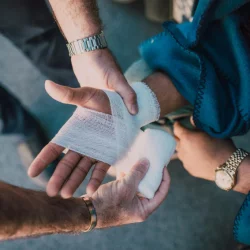What to Do After Being Bitten by a Dog
Steps to Take After a Dog Bite
A dog bite can be a traumatic and scary experience, potentially leading to serious injuries or infections. According to the American Veterinary Medical Association, more than 4.5 million people are bitten yearly. Acting promptly ensures your safety and helps in legal or insurance claims. Follow these steps immediately after being bitten by a dog.
- Clean the Wound Thoroughly
Immediately after a dog bite, rinse the wound with warm water and use antibacterial soap to prevent infections. If the area of the bite is bleeding, apply pressure with a clean cloth or sterile bandage. Use an antiseptic solution like hydrogen peroxide or iodine to disinfect the area.
- Control Bleeding
If the wound is bleeding heavily, keep it elevated and apply firm pressure with a clean cloth or sterile gauze. For deep puncture wounds, avoid excessive washing as it may drive bacteria deeper into the tissue.
- Apply an Antibiotic and Bandage the Wound
After cleaning, an antibiotic ointment such as Neosporin should be applied to help prevent infection. Cover it with a sterile bandage to protect it from further contamination.
- Seek Medical Attention
Even if the bite seems minor, it is crucial to consult a healthcare professional. Some dog bites can introduce bacteria such as Pasteurella, Staphylococcus, or Streptococcus, which may lead to severe infections. You may also need a tetanus shot if you haven't had one in five years.
Identifying the Dog and Reporting the Incident
- Identify the Dog and Its Owner
If possible, determine the dog owner's information, including their name, contact details, and vaccination records. If the dog is a stray, notify animal control services immediately.
- Verify Rabies Vaccination Status
Rabies is a deadly virus, and if the dog is unvaccinated, you may require post-exposure prophylaxis (PEP) to prevent infection. If the dog's vaccination status is unknown, your doctor will assess the need for rabies treatment.
- Report the Bite to Authorities
Local health departments or animal control agencies may require that you report dog bites, especially if the dog is aggressive or unvaccinated. This helps prevent future attacks and ensures necessary action is taken.
Understanding Potential Health Risks
- Infections from Dog Bites
Approximately 10-15% of dog bites become infected due to bacterial exposure. Symptoms of an infected bite include:
- Redness and swelling around the wound
- Pus or fluid discharge
- Fever and chills
- Increased pain or tenderness
- Rabies Risk and Symptoms
Rabies is rare but fatal if untreated. Early symptoms include fever, headache, muscle weakness, and later progress to hallucinations, paralysis, and confusion. If rabies exposure is suspected, immediate treatment is necessary.
- Nerve or Tissue Damage
Deep bites can cause nerve, muscle, or tendon damage, leading to long-term complications. Severe injuries may require surgical intervention.
Legal Rights and Compensation After Being Bitten
- Determining Liability for the Dog Attack
In many cases, dog owners can be held legally responsible for bites caused by their pets. Liability laws vary by state but typically fall under strict liability or negligence statutes.
- Strict liability laws hold dog owners responsible regardless of whether the dog showed previous aggression.
- Negligence laws require proof that the owner failed to control their dog, leading to the attack or prior biting incidents.
- Documenting the Incident for Legal Purposes
To strengthen your claim, collect the following evidence:
- Photographs of the wound and the location of the incident
- Medical records detailing treatment and expenses
- Eyewitness statements
- Police or animal control reports
- Filing a Personal Injury Claim
You may be eligible for compensation if the bite results in medical bills, wages, or emotional distress. A personal injury attorney can help you pursue a claim against the dog owner's insurance.
Preventing Dog Bites in the Future
- Understanding Dog Behavior
Recognizing warning signs can prevent attacks. Dogs may bite if they feel:
- Threatened or cornered
- Fearful or anxious
- Protective of their territory or owner
- Avoiding High-Risk Situations
- Do not approach unfamiliar dogs without permission
- Avoid staring directly into a dog's eyes, as this can be seen as a threat
- Teach children to respect a dog's space and avoid rough play
- Training and Socializing Your Dog
Proper training and socialization help prevent aggressive behaviors if you own a dog. Enroll your pet in obedience classes and ensure they are comfortable around people and other animals.
Conclusion
Being bitten by a dog requires immediate medical attention, legal action if necessary, and preventive measures to reduce future risks. If you or a loved one has suffered from a dog bite injury, it is essential to seek medical care, report the incident, and understand your legal rights to compensation.
More to Read:
Previous Posts:




